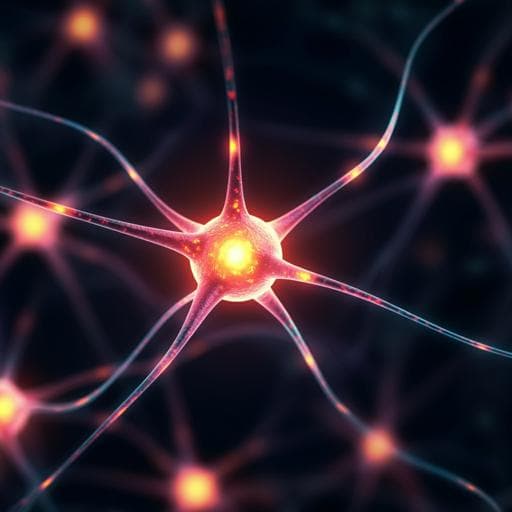
Biology
In vivo volumetric imaging of calcium and glutamate activity at synapses with high spatiotemporal resolution
W. Chen, R. G. Natan, et al.
Discover groundbreaking advancements in neuronal imaging with an innovative adaptive optics method developed by Wei Chen and collaborators. This research enhances the resolution and sensitivity of synaptic measurements in living organisms, enabling precise volumetric analysis of calcium and glutamate dynamics.
~3 min • Beginner • English
Introduction
The study addresses the challenge of imaging neuronal synapses in vivo with both high spatial (submicron to resolve synapses) and high temporal (sub-second) resolution over 3D volumes at depth. Two-photon fluorescence microscopy (2PFM) is widely used for deep tissue imaging, but maintaining diffraction-limited resolution in vivo requires adaptive optics (AO) to correct sample-induced aberrations. Volumetric functional imaging is limited by the need to scan in 3D; using a Bessel beam converts 2D frame rates to 3D volume rates due to its axially elongated focus, enabling faster volumetric imaging with synapse-resolving lateral resolution. However, Bessel foci, like Gaussian foci, suffer from sample-induced aberrations that distort the beam profile, and the impact of different aberration modes and effective correction strategies were not well characterized. The authors present a method to correct Bessel focus aberrations by manipulating the excitation wavefront at the objective focal plane, aiming to recover diffraction-limited performance at depth and enable accurate volumetric measurements of synaptic calcium and glutamate activity in vivo.
Literature Review
Prior work established 2PFM as a deep tissue imaging modality and highlighted the necessity of AO to correct optical aberrations for diffraction-limited resolution in vivo. Bessel focus scanning has been used to achieve fast volumetric imaging while maintaining lateral resolution (e.g., in zebrafish larvae and mouse brain). Although Bessel beams have been described as self-healing and more resistant to perturbations than Gaussian beams, other studies report that Bessel beams can be degraded by aberrations and their resilience depends on disturbance type and metrics. Theoretical and experimental studies suggest specific sensitivities of Bessel beams to different aberration modes. Existing AO typically applies phase-only correction at the pupil plane, which may be insufficient for Bessel beams due to coupled phase and amplitude distortions when aberrations occur away from the pupil plane.
Methodology
The authors built an AO Bessel focus scanning 2PFM based on a homebuilt AO 2PFM. Key components: two phase-only liquid crystal SLMs. SLM1 (conjugated to objective focal plane) is used to generate the Bessel beam and perform focal-plane AO; SLM2 (conjugated to the objective back pupil plane) is used for indirect wavefront sensing and AO of the Gaussian focus. In Bessel mode, a circular binary phase pattern on SLM1 diffracts energy into ±1 orders; a lens (L1) and an annular transmission mask generate a 0.4-NA Bessel focus (axial FWHM ~43 µm at 940 nm). In Gaussian mode, SLM1 is flat, and L1/mask are removed. System aberrations are first measured and corrected using pupil-segmentation-based indirect wavefront sensing on SLM2 with Gaussian illumination; this achieved diffraction-limited Gaussian PSFs (axial FWHM ~1.08 µm) and a 3× signal increase on 0.1-µm beads. For Bessel illumination, phase-only pupil-plane correction (SLM2) yielded only ~10% signal improvement, attributed to amplitude distortions at the pupil plane from off-pupil plane aberrations.
To correct both phase and amplitude distortions for Bessel focus, the authors compute a focal-plane corrective phase pattern for SLM1. Procedure: (1) Fit the pupil-plane corrective wavefront (measured via pupil segmentation) with the first 55 Zernike modes and remove tip, tilt, and defocus (to avoid mask misalignment and skewed axial intensity). (2) Apply the annular mask to the corrective phase and Fourier transform within the annulus to compute the complex field at the focal plane; use its phase as the focal-plane SLM1 pattern. (3) With SLM1 displaying this phase-only map and SLM2 flat, the propagated field at the pupil plane recovers both desired amplitude and corrective phase within the annulus (validated by inverse Fourier transform simulations). This focal AO improved Bessel-excited bead signal by 2.2× versus 1.1× with pupil AO. All biological “No AO” data are acquired with system aberration corrected, so improvements arise from sample-induced aberration correction.
Aberration sensitivity characterization: Introduce selected low-order Zernike modes (defocus, coma, astigmatism, trefoil, spherical, each 1 wave) on SLM2 and measure two-photon signals and PSFs (0.1-µm beads) for Gaussian (1.05 NA) and Bessel (0.4 NA) foci. Analyze lateral and axial profiles and peak intensities; compare with numerical models including noncircular aberrations and with analytical derivations showing ideal Bessel beams are insensitive to Zernike modes with azimuthal index m ≤ 1 (e.g., coma, spherical) and more sensitive to m > 1 (e.g., astigmatism, trefoil).
In vivo imaging: Mouse V1 through cranial window (No. 1.5 coverslip). Morphology: Thy1-GFP mouse, depths up to 500 µm. Functional calcium imaging: wild-type mice expressing GCaMP6s/7s sparsely via AAV (Cre/Cre-dependent strategy), awake with drifting grating stimuli (12 directions). Glutamate imaging: iGluSnFR.A184S expression; Bessel focus alternated between two depths (apical, basal dendrites) using objective piezo to achieve 1.6 volumes/s over 128×128×120 µm³. Zebrafish larval hindbrain imaging in Tg(isll:GFP); exogenous bead for AO measurement.
Visual stimulation: full-field drifting gratings (12 directions, 0–330°, 30° steps), 100% contrast, 0.07 cyc/deg, 26°/s (2 Hz). Timing: Gaussian mode 8 s trials (2 s blank, 4 s grating, 2 s blank), frame rate 3.3 Hz; Bessel mode 12 s trials (4 s blank, 6 s grating, 2 s blank), frame rate 1.5 Hz; 10–20 trials.
Image processing: Registration (Gaussian: iterative cross-correlation; Bessel: NoRMCorre). Morphological Bessel images optionally deconvolved with calculated diffraction-limited Bessel PSF; functional analyses without deconvolution. ROI-based extraction; ΔF/F computation with baseline defined from pre-stimulus blanks. Calcium transient threshold ΔF/F ≥ 20%; glutamate responses threshold ΔF/F0 > 5–10% (noted as >5% in methods, summary panels used >10% for counts). Orientation selectivity assessed with one-way ANOVA (p < 0.05), fitted with bimodal Gaussian; gOSI computed. Post-objective laser powers matched between “No AO” and “AO” conditions per experiment.
Key Findings
- Focal-plane AO for Bessel focus (SLM1) substantially outperforms pupil-plane AO (SLM2) for Bessel illumination: on 0.1-µm beads, signal improved 2.2× with focal AO vs ~1.1× with pupil AO at 940 nm (0.4-NA Bessel, axial FWHM 43 µm). Gaussian focus system correction improved bead signal 3× and achieved axial FWHM ~1.08 µm.
- Aberration sensitivity: For Gaussian focus, non-defocus aberrations (coma, astigmatism, trefoil, spherical) markedly degrade signal and axial PSF. For Bessel focus, coma and spherical aberrations minimally reduce peak intensities, while astigmatism and trefoil redistribute energy to side lobes and more severely reduce signal than in Gaussian. Analytical derivation: ideal Bessel beams are only sensitive to Zernike modes with azimuthal index m > 1; insensitive to modes with m ≤ 1 (e.g., Z3 1 coma, spherical), explaining observed robustness.
- In vivo morphology (mouse V1): Correcting cranial window-induced aberrations improved dendrite/spine resolution and brightness in superficial cortex for both Gaussian and Bessel; Bessel less affected by spherical/coma from cranial windows; maximal signal improvement smaller for Bessel (2.1×) than Gaussian (2.5×). At depth (~200–260 µm), tissue aberrations including trefoil degraded Bessel more strongly; AO yielded up to 4× spine signal increase with Bessel vs up to 3× with Gaussian, resolved more spines, and enhanced high spatial frequencies in Fourier spectra. Near-diffraction-limited resolution confirmed at ~500 µm depth after AO in layer 5 imaging.
- Calcium imaging (mouse V1, GCaMP7s): With AO Bessel imaging over 128×105×60 µm³ (340–400 µm depth), 91 spines were observed; 58% (53/91) showed visually evoked responses (ΔF/F > 20%) with AO vs 21% (19/91) without AO. gOSI across spines increased with AO (median 0.30 vs 0.23; paired t-test p < 0.001; K–S p < 0.001), revealing orientation selectivity in dendrites and spines not detectable without AO.
- Glutamate imaging (iGluSnFR.A184S): Simultaneous volumetric monitoring of apical and basal dendritic branches at 1.6 volumes/s (128×128×120 µm³). AO enabled identification of many spines and detection of glutamate transients otherwise invisible. Counts of visually evoked spines (ΔF/F0 > 10%): apical 26/182 with AO vs 8/182 without; basal 44/143 with AO vs 10/143 without. Orientation-selective spines: apical 18 with AO vs 2 without; basal 17 with AO vs 3 without (ANOVA p < 0.05). Preferred orientation distributions differed markedly between apical and basal spines with an ~81° shift in dominant orientations (apical ~144°, basal ~63°) and broader tuning in apical (FWHM ~92°) vs basal (FWHM ~46°).
- Depth performance: Demonstrated volumetric imaging improvements down to 500 µm in mouse cortex and in zebrafish larval hindbrain, with increased sensitivity and resolution for neuronal processes and synapses.
Discussion
The work addresses limitations in achieving simultaneous high spatial and temporal resolution in vivo by combining Bessel focus scanning with adaptive optics optimized for Bessel illumination. Conventional pupil-plane phase-only AO is insufficient for Bessel beams because sample-induced aberrations away from the pupil plane impart both phase and amplitude distortions at the pupil, degrading Bessel focal intensity more than Gaussian. The proposed focal-plane AO computes a phase pattern at the focal plane that, upon propagation, corrects both phase and amplitude distortions at the pupil plane, recovering diffraction-limited Bessel performance. Systematic analysis showed Bessel beams are relatively robust to aberration modes with azimuthal index m ≤ 1 (e.g., coma, spherical), but more vulnerable to astigmatism and trefoil. In vivo, the focal AO Bessel approach significantly enhances SNR and resolution, enabling accurate detection of calcium and glutamate transients and more reliable characterization of synaptic tuning properties. The method reveals functional properties across volumes, including simultaneous apical and basal spine glutamate responses with distinct preferred orientation distributions, insights that would be missed without AO. The broader applicability of focal-plane correction to other small-pupil-footprint imaging modalities suggests potential for improving volumetric functional imaging across systems.
Conclusion
The study introduces a high-efficiency focal-plane adaptive optics method for Bessel focus scanning 2PFM that corrects both phase and amplitude distortions, restoring diffraction-limited imaging at depth. This enables fast volumetric imaging with synapse-level lateral resolution in vivo, improving structural visualization of dendrites and spines and enhancing sensitivity and accuracy for calcium and glutamate activity measurements. Key contributions include: (1) a computationally derived focal-plane phase pattern for aberration-corrected Bessel generation; (2) theoretical and experimental characterization of aberration sensitivities of Bessel vs Gaussian beams; (3) demonstration of improved volumetric synaptic activity imaging down to 500 µm depth; and (4) simultaneous measurement of apical and basal dendritic spine glutamate tuning with distinct preferred orientations. Future directions may include integrating alternative wavefront sensing methods with the focal AO framework, extending to other microscopy modalities with small pupil footprints, and combining with demixing algorithms to unmix overlapping synaptic signals in volumetric Bessel images.
Limitations
- The focal-plane corrective pattern is discontinuous with high spatial frequencies, making deformable mirrors impractical for implementing focal AO; liquid-crystal SLMs are required, which may limit system designs and update speeds.
- Aberration measurements rely on indirect wavefront sensing (pupil segmentation) using bright beacons (beads or cell bodies), and corrections are local; biological tissues introduce complex, spatially varying aberrations, so a single correction may be limited by the isoplanatic patch size.
- Although deconvolution improves image quality, it does not substitute for AO; functional analyses were performed without deconvolution.
- Frame rates and post-objective powers differ between Gaussian and Bessel modes due to energy distribution into side rings; while powers were matched across AO conditions within modes, overall sensitivity comparisons across modes must consider these differences.
- Reported robustness of Bessel beams applies to specific aberration modes (m ≤ 1); other modes (e.g., astigmatism, trefoil) can still substantially degrade performance, necessitating AO.
Related Publications
Explore these studies to deepen your understanding of the subject.







